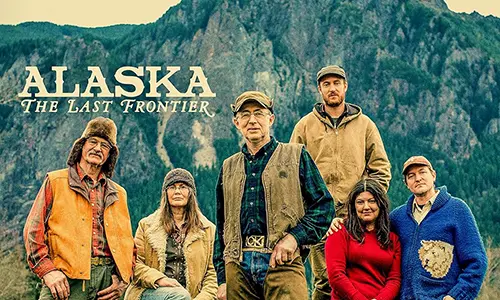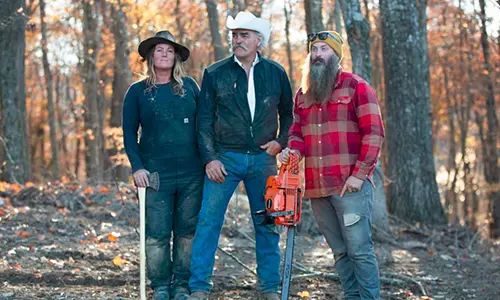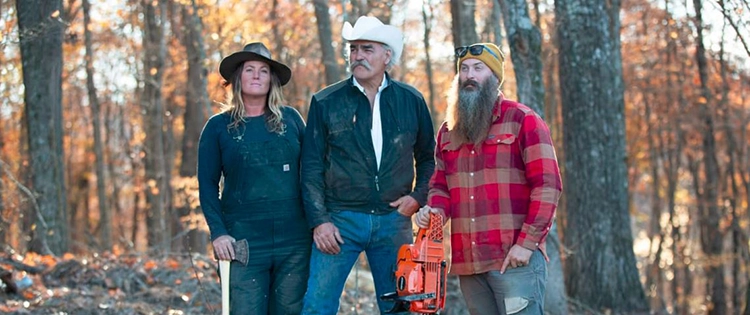There’s no doubt – homesteading reality shows have captivated millions of us dreaming of a simpler, more self-sufficient lifestyle. Here are mistakes from homesteading TV shows that you probably make.
Many of us make costly mistakes, like those seen on these shows, that can quickly derail our self-sufficient goals.
This post exposes the top 9 pitfalls from popular homesteading shows to help you avoid repeating them.
Mistakes from “The Pioneer Woman”
Trying to Do Everything Yourself
“The Pioneer Woman” is one of many homesteading TV shows I watched.
Ree Drummond made ranch life look flawless but admitted to neglecting things like her kids’ schooling.
Most homesteaders try to juggle it all—farmer, chef, teacher, accountant, and handyman. But doing everything alone is a quick path to burnout and inefficiency.
Related: These Mistakes Could Kill Your Livestock
Managing a homestead is a full-time job, and one person can’t realistically handle it all while taking on extra responsibilities.
Homeschooling, childcare, running a side business, and managing repairs add to the load.
On top of that, there’s gardening, canning, meal prep, healthcare, record-keeping, and legal matters. Balancing all these tasks takes teamwork or careful planning to avoid burnout.
Get smart about setting realistic limits. Outsource or enlist help where you lack expertise. Explore hiring farmhands, tradespeople, and teachers or even joining a local community with divided duties. Know when being a rugged individualist puts too much on one person’s plate.
Neglecting Preventative Maintenance and Upgrades
Every beautiful shot of Drummond’s ranch hides the truth—maintaining aging infrastructure is constant and crucial. Skipping preventative maintenance is a common mistake for off-gridders.
Areas requiring constant upkeep include:
Area Risks of Poor Upkeep Fencing Livestock escapes, predator invasions Barns/Buildings Structural failures, inefficient insulation Power Systems Brownouts, blackouts, hazardous conditions Plumbing/Water Leaks, contamination from old pipes Machinery Breakdowns, injuries from negligence
Don’t fall behind on structural inspections, repairs, upgrades, and scheduled servicing.
Skimping leads to compounding disasters and unnecessary expenses later. Work preventative tasks like fence mending and canal clearing into your schedule and budget.
Going All-In Without a Transition Plan
When we first met Ree, she had just gone from city life to ranch wife overnight.
While her struggles make for great TV, most homesteaders shouldn’t dive in so quickly.
Upending your comfortable metropolitan routine entirely for off-grid living is a recipe for burnout and remorse.
Instead of a sudden shift, take it slow. Start with urban homesteading, like gardening, to ease into the lifestyle. Consider renting a rural property before buying land. Keep one steady income while transitioning to a new role.
Learn new skills, like livestock care, through lessons or hands-on practice. Gradually make home and utility upgrades as you adjust. This approach helps prevent overwhelm while building a strong foundation.
Get your feet wet slowly. Master self-reliance skills at a measured pace before fully exiting the rat race.
Mistakes From “Alaska: The Last Frontier”

Source: Alaska: The Last Frontier TV Show
Insufficient Water Storage/Access
Freshwater is a must for any homestead, whether for home, farming, or firefighting needs.
The Kilcher family, however, has faced ongoing struggles due to poor preparation in this area.
One year, drought and well pump failures forced them to ration water. Another time, wildfires nearly drained their fire suppression reserves. These situations highlight the importance of having enough clean water.
To avoid this, take proactive steps to secure your water supply. Drill a deep, high-output well or tap into springs or creeks. Install large cisterns to capture rainwater runoff.
Build containment ponds, pools, or tanks to store extra water. Set up purification systems for safe water. Finally, maintain backup pumps, power, and fire suppression gear for emergencies.
Water is the lifeblood of any homestead. Ensuring multiple reliable, renewable sources should be your first priority.
Ignoring Weather Warnings and Seasonal Hazards
In Alaska’s harsh, unpredictable climate, the Kilchers often put themselves at risk by ignoring weather alerts and seasonal dangers.
One wildfire nearly trapped them, while in another episode, they barely escaped a blizzard. These incidents highlight how quickly natural hazards can become life-threatening.
Any thriving homestead should develop thorough seasonal preparedness plans:
Spring/Summer Safety:
- Reinforce structures against high winds, lightning
- Implement fire prevention and mitigation measures
- Stockpile food/reserves in case of flood isolation
Fall/Winter Preparedness:
- Insulate all buildings, pipes, and equipment properly
- Plow roads, clear debris from roofs/gutters
- Store heating fuel, wood reserves, and cold-weather gear
By respecting Mother Nature’s power and perpetually preparing for her worst, you protect your family, livestock, and property from avoidable calamities.
Poorly Constructed Buildings and Shelters
The Kilcher family’s makeshift homesteads, outbuildings, and animal shelters often fail to protect them from Alaska’s harsh conditions.
The show frequently shows leaking, collapsing shelters, poor insulation, heating issues, and unsafe, code-violating structures. These substandard buildings put the family at risk of hypothermia, injury, or livestock losses.
Proper construction is crucial for safety and compliance. Use stable framing and roofing to ensure durability.
Related: 11 Must-Have Items for Your Wilderness Survival Shelter
Install plenty of insulation and weatherproofing to keep your space comfortable and energy-efficient. Ensure you have proper heating and ventilation systems.
Always follow building codes and zoning laws to avoid legal issues. Use durable, low-maintenance materials that last.
Building remote structures can be tough, but cutting corners isn’t an option. Get professional help to create shelter you can rely on.
Mistakes from “Homestead Rescue”

Source: Homestead Rescue TV Show
Poor Livestock Management
Raising livestock is key to most homesteads, but Homestead Rescue often finds herds and flocks mismanaged due to poor food, shelter, fencing, and overall care.
One Missouri family let their chickens roam free, leaving them exposed to predators. In Canada, dairy cows went months without milking.
These cases of neglect, whether intentional or not, harm livestock health and productivity.
To keep your animals healthy, start by building secure enclosures and fencing. Provide shelters with shade, insulation, and protection from the weather. Ensure a steady supply of quality feed and fresh water.
Stick to regular milking schedules and routine vet checkups. Practice rotational grazing and humane treatment to keep your animals thriving. Livestock are valuable homestead assets that need proper care.
Underestimating Labor Requirements
While the self-sufficient lifestyle can be immensely rewarding, most underestimate how grueling and physically demanding modern homesteading actually is.
Tending crops, and livestock, repairing equipment, gathering firewood – it adds up to a never-ending onslaught of labor-intensive chores.
Too many Homestead Rescue homesteaders find themselves overwhelmed and burning out rapidly from underestimating workloads.
One couple tried running their 35-acre farm entirely themselves with no outside help. Another family had so many strenuous tasks, they neglected basic property maintenance.
To prevent exhaustion and burnout on your homestead:
- Realistically evaluate all residential, agricultural, and utility workloads
- Split up responsibilities among all able-bodied household members
- Look for efficiencies like multi-use tools, systems, and practices
- Identify off-season downtimes to catch up on projects
- Don’t be afraid to scale back operations to a manageable size
- Hire temporary labor for intensive peaks like planting/harvests
- Build a community to share/trade workloads among neighbors
Homesteading requires tireless commitment, but you need to accept your own limitations and capacities. Adjusting workloads appropriately lets you enjoy a self-reliant lifestyle without burning out.
Unsafe Practices and Procedures
From heavy machinery and live power lines to stockpiled fuel and structural collapses – homesteading is fraught with health and safety hazards if not approached cautiously.
Unfortunately, Homestead Rescue depicts incident after incident stemming from unsafe homesteading practices.
Severe injuries occurred when a family conducted amateur demolition without proper protective equipment.
Another homestead stored leaking gas containers inside their barn, creating a tinderbox fire scenario. These are exactly the types of preventable accidents to avoid.
To maintain a safe, secure homestead:
Safety First:
- Learn and follow all equipment operating procedures
- Wear appropriate personal protective equipment (PPE) at all times
- Properly store all flammable and hazardous materials
- Ensure electrical/utility systems meet building codes
With proper expectations set, homesteading reality shows can provide a general glimpse into the possibilities and challenges of our lifestyle.
However, they should be viewed as inspirational entertainment pieces, not comprehensive instructional guides to be blindly followed.
How many homesteading TV shows have you watched? Which one of these TV shows you loved the most? Let us know in the comments below!
These Mistakes Could Kill Your Livestock
Why You Should Never Hide Your Stockpile In Your Basement (Video)











